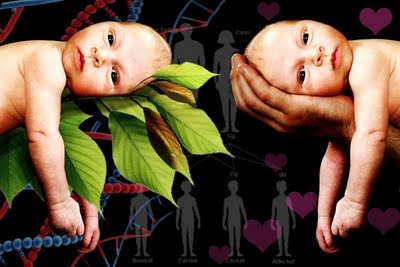Nature, or Nurture--Again, or Still?

Nature versus Nurture: The Controversy
Abstract
Throughout the history of psychology there has been a conflict between theorists and researchers who believe that behavior is based upon learning and how one is nurtured, and those who believe that people are born with innate behaviors that cannot be altered by education or training or external forces. There are also professionals who believe that a little bit of both nature and nurture work together to create the whole person; how they behave, what they do, what they are resistant to, and what they have the potential to do. This author believes that nature has a stronger influence on behavior than nurture does. The idea that a person can become addicted to a substance, that they will choose to become a rocket scientist or rock star, or whether they are a serial killer all come more from what their brains process than what comes from external stimulation or influence.
*****
There is a lot to be said for familial genetics when one looks at characteristics like eye color, hair color, or the height of a person. It is much more controversial, however, to consider genetics to determine where a person’s behavior comes from. One must wonder why a mother like Andrea Yates took the lives of her five children while Brooke Shields did not, although they both suffered from severe postpartum depression (Friedman, & Sorrentino, 2012; Thurgood, Avery, & Williamson, 2009). What prompts one man from the inner city to become a physician while another in the same neighborhood becomes a gang member who kills people with no remorse? These examples would lend themselves toward a consideration that more than environment and exposure can develop specific behaviors in anyone. As every person is different on the outside, they are also different neurologically and cognitively. The way a person deals with their personal demons, opportunities, or experiences seems to have a lot more to do with chemical and physiological makeup; even in those situations where there are no family members who have displayed any adverse or negative behaviors themselves.
Genetics
Much like a child who is born with a hole in his heart, or with only one hand, abnormalities can be formed below the surface of the skin—in regions where the naked eye is incapable of seeing. Unlike a physical deformity, a neurological abnormality may lie latent until a specific stimulus or event triggers it and creates changes in the behavior of the person who possesses the abnormality. In both physical and neurological abnormalities, there may be no genetic tie to a family member, or the abnormality may have been in a recessive gene for generations before coming to the surface.
Research by Koehl, van der Veen, Gonzales, Piazza, and Abrous (2012) indicates that a link between how one can be raised and their genetic propensity toward specific behaviors can be proven. Their findings indicate that environmental stimulus can have an effect on behavior but only in situations where the subject was vulnerable by genetic traits (Koehl, et al., 2012). They also determined that the difference in nurturing by subjects was not an influence if the genetic propensity toward a behavior did not exist (Koehl, et al., 2012).
In addition to the study by Koehl, et al. (2012), Kaprio (2012) also addresses the link between the genetic potential and environmental stimulus to support a behavior. In both Koehl, et al. (2012) and Kaprio (2012) results is the undeniable identity of genetics being involved in the behavioral functioning of individuals. If the gene for a trait did not exist, then the behavior was not produced.
Collaborative Behaviors
Wright, et al. (2012) discuss that certain neurohumoral agents, like oxytocin, are identified in promotion of collaborating behaviors. They find that testosterone, an androgen hormone, is an opponent to the effects of oxytocin which affects how information is accumulated and processed. Their findings indicate that testosterone in higher levels affects cooperative and collaborative behaviors by causing the individual to behave in a more autonomous and egocentric manner, which are not conducive to working well with others (Wright, et al., 2012). These findings are another indication of the strength of nature over nurture in the debate surrounding where individuals retrieve their behaviors.
Environmental Influences
There is opportunity for most individuals to change their behavior based upon those environmental events or influences that they are exposed to on a daily basis. However, there is no definitive proof that genetics does not also play its part in the behavioral scheme of all humans. Jacobson (2009) indicates that the influence of genes over environment can be countered as well by environmental influences that can alter genetic propensity. She writes that if a person is treated poorly, or well, by a peer group in earlier life, that particular treatment will transfer to a person in future situations and help to dictate behavior in future moments. Jacobsen goes on to address genetically potentiated behaviors are not always displayed. There is environmental influence involved in many of the more maladaptive behaviors of criminality.
If Jacobson’s report is true then that should also work in the reverse; if a person who does not have the genetic potential toward criminal behavior and then is exposed to it, they will not turn to criminal behavior because it is not genetically bound to their behavior.
Society and Social Interaction
As the debate ensues there is more agreement that genetics have a strong influence on a person’s behavior. Serotonin and opioid neurotransmitters have been determined to provide information on different sensitivities in social settings, and how individuals respond in societal situations and with their experiences involving others (Baldwin, & Lieberman, 2010). Their findings determined, also, that depression is also influenced by specific levels of alleles that were prevalent in individualistic populations, heightening the preponderance of depression among these populations (Baldwin, & Lieberman, 2010).
Once again, nature has an influence on behaviors, including environmental societal groups. Baldwin, and Lieberman (2010) indicate that those populations who are collectivist have specific alleles, and populations who live in more individualistic societies have different ones. Did the cultures create modifications in the genetic code of those in their groups, or did the groups choose to become part of their societies because of their genes? DNA strings in people from different cultural groups can be measured and have been shown to be good indicators of which demographics will suffer from depression. The demographics are shown to be in more individualistic societies of Western Europe (Baldwin, & Lieberman, 2010).
Jacobson (2009) also includes information regarding serotonin levels and depression in people in different cultures, socioeconomic groups, and people who experience stressful environments or events. With the information collected by Balwin and Lieberman (2010) and Jacobson (2009) and others, the strength in determining that nature has a stronger influence on human behavior than nurture is expanding.
Dangerous Behavior
Risk-taking behavior also has a biological source. There are findings indicating a strong relationship between activation in the bilateral inferior parietal lobule, temporal visual regions and parieto-occipital visual areas in those people who had just experienced a risk-taking behavior (Tamura, et al., 2012). As a teenager progresses through their age to closer to adult age, their risk-taking behavior reduces in most instances (Tamura, et al., 2012). This is likely related to additional psychological development that comes naturally with maturity (Moshman, 2011). Environment and culture has a great deal of influence on how teenagers are treated, but their development is more like an adult once they reach teen years, and if given the chance, they would use their natural development to perform at higher levels of thinking and behavior than they are given credit for in more recent years, especially in Western cultures (Moshman, 2011). Development into the teen years, adolescence, is attributed to genetic, pubescent, changes in the human body. This is another indication of how nature has the upper-hand over nurture in the behaviors and choices of a person.
Criminal or Violent Behavior
The controversy of nature over nurture is strongest in criminal and violence cases in courts of law across the Western world. There are some findings that indicate that up to 40% of the population may have alleles like MAOA-L variant, which may or may not cause a person to become violent or perform criminal acts (Hunter, 2010). There is also indication that those who are found to have the most potential to violent behavior do have the allele MAOA-L (Hunter, 2010). Those who do have the MAOA-L also were shown, with fMRI studies, to have smaller limbic systems, which help control emotion, behavior, and long-term memory (Hunter, 2010). They also showed amygdale that was hyperresponsive during specific tasks like imitation of facial expressions (Hunter, 2010). They were not able to block strong emotions.
Conclusion
There will be debate over the environment and genetic potential for many more years to come, but as technology advances, and more researchers dig into the root cause of both positive and negative behaviors, as well as other human characteristics, the debate may very well lean more toward nature over nurture. Current research indicates a link between both, rather than one or the other, however there are also studies that indicate that without the genetic potential for specific behaviors, they are not as likely to show up once an environmental influence has been introduced into their lives. Twins, single births, people raised by their own family or raised by another family, and individuals in both affluent and low-income environments have been seen to possess the same potentials to behaviors if their neurological structures, DNA, limbic systems, and neurotransmitter systems are similar. These findings are strong indication of how important nature is when it comes to psychological behavior in a person, no matter where they live, or with whom.
References
Baldwin, M. W., & Lieberman, M. D. (2010). Is there a genetic contribution to cultural differences? Collectivism, individualism and genetic markers of social sensitivity. Social Cognitive, and Affective Neuroscience, 5(2-3), 203 – 211, doi:10.1093/scan/nsq059
Friedman, S. H., & Sorrentino, R. (2012). Commentary: Postpartum psychosis, infanticide, and insanity—implications for forensic psychiatry. Journal of American Academy Psychiatry and the Law Online, 40(3), 326 – 332. Retrieved from http://www.jaapl.org/content/40/3/326.full.pdf+html
Hunter, P. (2010). The psycho gene. EMBO Reports, 11(9), 667 – 669, doi:10.1038/embor.2010.122
Kaprio, J. (2012). Twins and the mystery of missing heritability: The contribution of gene-environment interactions. Journal of Internal Medicine, 272(5), 440 – 448, doi:10.1111/j.1365-2796.2012.02587.x
Koehl, M., van der Veen, R., Gonzales, D., Piazza, P. V., & Abrous, D. N. (2012). Interplay of maternal care and genetic influences in programming adult hippocampal neurogenesis [Abstract]. Biological Psychiatry, 72(4), 282 – 289, doi:10.1016/j.biopsych.2012.03.001
Moshman, D. (2011). Adolescents are young adults, not immature brains. Applied Developmental Science, 15(4), 171 – 174, doi:10.1080/10888691.2011.618098
Tamura, M., Moriguchi, Y., Higuchi, S., Hida, A., Enomoto, M., Umezawa, & Mishima, K. (2012). Neural network development in late adolescents during observation of risk-taking action. PLoS One, 7(6), doi:10.1371/journal.pone.0039527
Thurgood, S., Avery, D. M., & Williamson, L. (2009). Postpartum depression (PPD). American Journal of Clinical Medicine, 6(2), doi:10.1007/BF02686581
Wright, N. D., Bahrami, B., Jouhson, E., Di Malta, G., Rees, G., Frith, C. D., & Dolan, R. J. (2012). Testosterone disrupts human collaboration by increasing egocentric choices. Proceedings of the Royal Society, Biological Sciences, 279(1736), 2275 – 2280, doi: 10.1098/rspb.2011.2523








